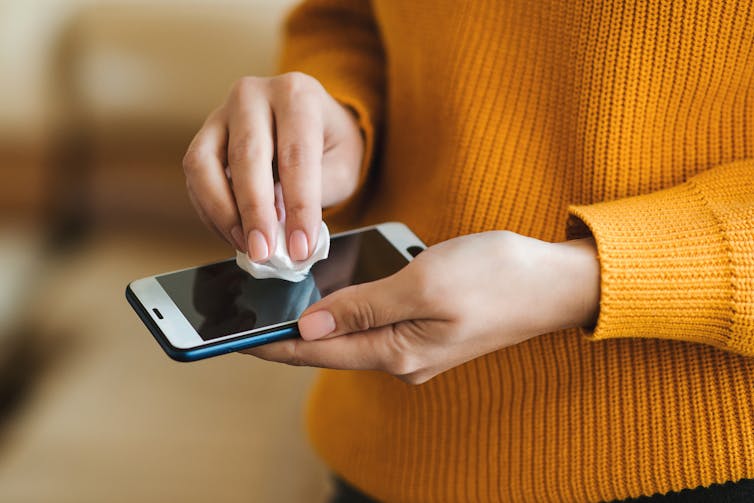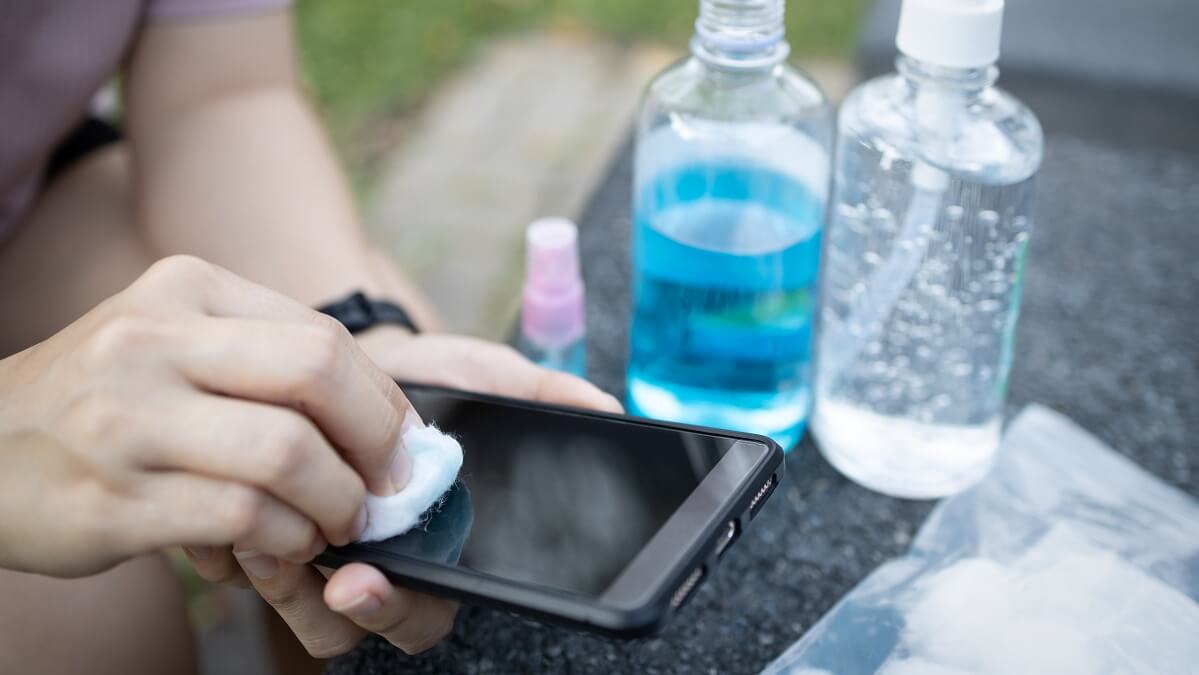Primrose Freestone, University of Leicester
We carry them everywhere, take them to bed, to the bathroom and for many people they’re the first thing they see in the morning – more than 90 per cent of the world owns or uses a mobile phone and many of us couldn’t manage without one.
But while health concerns about phone use usually focus on the distraction they can cause while driving, the possible effects of radio frequency exposure, or just how addictive they can be. The microbial infection risk of your phone is much less appreciated – but it’s very real.
A 2019 survey found that most people in the UK use their phones on the toilet. So it’s not surprising to discover studies have found our mobile phones to be dirtier that toilet seats.
We give our phones to children to play with (who aren’t exactly well known for their hygiene). We also eat while using our phones and put them down on all sorts of (dirty) surfaces. All of which can transfer microbes onto your phone along with food deposits for those microbes to eat.
It’s been estimated that people touch their phone hundreds if not thousands of times a day. And while many of us wash our hands regularly after say, going to the bathroom, cooking, cleaning, or gardening, we are much less likely to consider washing our hands after touching our phones. But given how disgusting and germ-infested phones can be, maybe it’s time to think more about mobile phone hygiene.
Popular plans right now
Germs, bacteria, viruses
Hands pick up bacteria and viruses all the time and are recognised as a route for acquiring infection. So too are the phones we touch. A number of studies conducted on the microbiological colonisation of mobile phones show that they can be contaminated with many different kinds of potentially pathogenic bacteria.
These include the diarrhoea-inducing E. coli (which, by the way, comes from human poo) and the skin-infecting Staphylococcus, as well as Actinobacteria, which can cause tuberculosis and diphtheria, Citrobacter, which can lead to painful urinary tract infections, and Enterococcus, which is known to cause meningitis. Klebsiella, Micrococcus, Proteus, Pseudomonas and Streptococcus have also been found on phones and all can have equally nasty effects on humans.
Research has found that many pathogens on phones are often antibiotic resistant, meaning they can’t be treated with conventional drugs. This is worrying as these bacteria can cause skin, gut and respiratory infections that can be life-threatening.
Research has also found that even if you clean your phone with antibacterial wipes or alcohol it can still be recolonised by microorganisms, indicating that sanitisation must be a regular process.

Volurol/Shutterstock
Phones contain plastic which can harbour and transmit viruses some of which (the common cold virus) can live on hard plastic surfaces for up to a week. Other viruses such as COVID-19, rotavirus (a highly infectious stomach bug that typically affects babies and young children), influenza and norovirus – which can cause serious respiratory and gut infections – can persist in an infectable form for several days.
Indeed, since the beginning of the COVID pandemic, the US Centers for Disease Control and Prevention has introduced guidelines for cleaning and disinfecting mobile phones – which, along with door handles, cash machines and lift buttons, are considered reservoirs of infection.
In particular, concern has been raised about the role mobile phones can play in the spread of infectious microbes in hospital and healthcare settings, as well as in schools.
Clean your phone
So it’s clear that you need to start cleaning your phone regularly. The US Federal Communications Commission actually recommends daily sanitation of your phone and other devices – not least because we are still within an active COVID-19 pandemic and the virus can survive for several days on hard plastic surfaces.
Use alcohol-based wipes or sprays. They need to contain at least 70 per cent alcohol to disinfect phone casings and touch screens, and it needs to be done every day if possible.
Do not spray sanitisers directly onto the phone and keep liquids away from connection points or other phone openings. Absolutely avoid using bleach or abrasive cleaners. And wash your hands thoroughly after you’ve finished cleaning.
Thinking about how you handle your phone will also help to avoid it becoming colonised with germs. When not at home, keep your phone in your pocket, or bag and use a disposable paper list of to-do items, rather than constantly consulting your phone. Touch your phone with clean hands – washed with soap and water or disinfected with alcohol-based hand sanitiser.
There are other things you can do to avoid your phone becoming a source of viruses. Do not share your phone with others if you have any infection, or have not first sanitised it. If children are allowed to play with your phone, sanitise it as soon as possible afterwards.
And get into the habit of putting your phone away when not in use, then sanitising or washing your hands. You might also want to occasionally sanitise your phone charger when you are cleaning your phone.
Primrose Freestone, Senior Lecturer in Clinical Microbiology, University of Leicester.
This article is republished from The Conversation under a Creative Commons licence. Read the original article.
How often do you wipe your phone? Will you be doing it more often now? Let us know in the comments section below.
Read also: Germ hotspots in your home and how to banish them


Interesting little article. Contains nothing that we weren’t aware of already. If a person were to take a sample from their mobile phone and also from inside their mouth what they would see on the blood agar dish after 48 hours incubation would shock them. Especially the similarities.
E coli is an indicator of fecal contamination. However, not all E coli is dangerous to us, in fact we have our own unique strains.
Washing our hands with soap and water is the safest for our own skin health as the alcohol ones do damage the skin and our natural biota.
The best anti viral method is placing your mobile phone in full sun (or other UV light source) for a few minutes regularly. This serves to denature any viral particles that may be present.
Keeping it “clean” and importantly, dry and practicing general good hygiene is probably the best strategy.